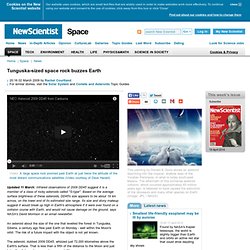

Tunguska-sized space rock buzzes Earth. Video: A large space rock zoomed past Earth at just twice the altitude of the most distant communications satellites (Video courtesy of Dave Herald) Updated 11 March: Infrared observations of 2009 DD45 suggest it is a member of a class of rocky asteroids called "S-type".

Based on the average surface brightness of these asteroids, DD45's size appears to be about 19 km across, on the lower end of its estimated size range. Its size and stony makeup suggest it would break up high in Earth's atmosphere if it were ever found on a collision course with Earth, and would not cause damage on the ground, says NASA's David Morrison in an email newsletter. An asteroid about the size of the one that levelled the forest in Tunguska, Siberia, a century ago flew past Earth on Monday - well within the Moon's orbit. The risk of a future impact with the object is not yet known. ¿Golpeará Apophis a la Tierra en 2036? Meteoro 2036 Apophis. Fire in the sky: Tunguska at 100. The Tunguska event was caused by a space rock tens of metres across At 7:17am on 30 June 1908, an immense explosion tore through the forest of central Siberia.

Some 80 million trees were flattened over an area of 2,000 square km (800 square miles) near the Tunguska River. The blast was 1,000 times more powerful than the atomic bombs dropped on Hiroshima and Nagasaki and generated a shock wave that knocked people to the ground 60km from the epicentre. The cause was an asteroid or comet just a few tens of metres across which detonated 5-10km above the ground, 100 years ago today.